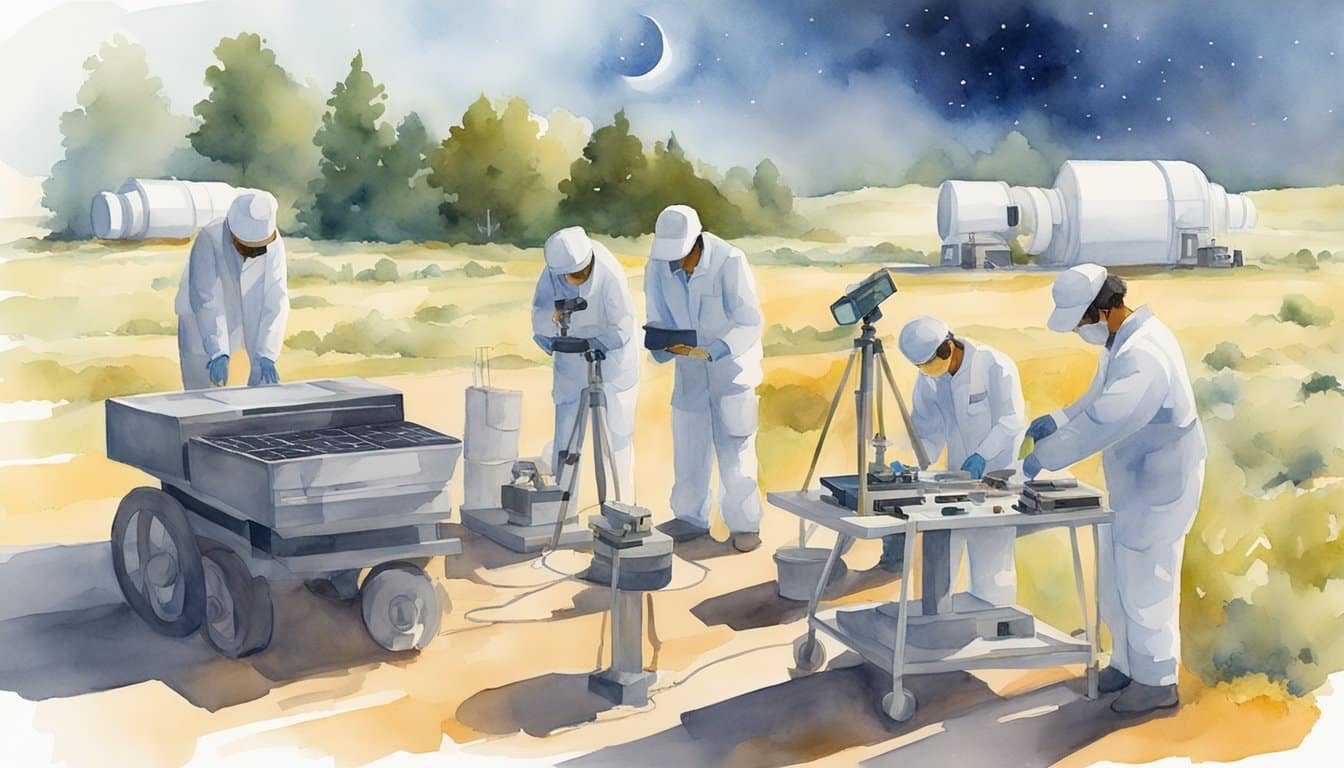Overview of the 2024 Solar Eclipse
Excitement is mounting as North America prepares for a remarkable astronomical event: the total solar eclipse on April 8, 2024. This awe-inspiring occasion is when the moon will completely cover the sun, casting a shadow on Earth and briefly turning day into night.
Significance of Total Solar Eclipses
Total solar eclipses are a dramatic demonstration of cosmic happenstance. When the moon orbits perfectly to obscure the sun, a deluge of scientific opportunities and public fascination unfolds. For astronomers and sky-watchers alike, the phenomenon presents a rare occasion to study the solar atmosphere, known as the corona, which is usually obscured by the sun’s bright light. Beyond science, total eclipses often inspire awe and wonder across the ages and cultures, highlighting the grandeur of our celestial ballet.
Key Dates and Times
April 8, 2024, marks the date when the total solar eclipse will trace a path across North America. The path of totality—where the moon will completely cover the sun—will begin in Mexico, traverse through the United States from Texas to Maine, and finish in the eastern parts of Canada. This makes it a spectacle accessible to millions of observers eager to witness this rare natural event.
| Location | Event | Local Time |
|---|---|---|
| Mazatlán, Mexico | Start of Totality | 13:07 CST |
| Dallas, Texas | Start of Totality | 13:17 CST |
| Indianapolis, IN | Start of Totality | 15:06 EST |
| Montreal, Canada | Start of Totality | 15:36 EDT |
Observation of the eclipse is not only a thrilling experience but also a moment that unites people under the shared sky, reminding everyone of the wonders of Earth and space. Whether one enjoys the eclipse for its beauty, its science, or its social gathering potential, the event promises to be unforgettable.
Path of Totality Across North America

On April 8, 2024, the path of totality of a solar eclipse will sweep across North America, offering observers an extraordinary spectacle. The shadow of the moon, known as the umbra, will create a narrow corridor where the full effect of the eclipse can be experienced.
Starting Point and Pacific Entrance
The celestial event will commence with the moon casting its shadow upon the surface of the Earth in the Pacific. As the solar eclipse begins, the path of totality will first make landfall in Mexico. Observers located along this initial point will have the opportunity to witness the eclipse’s entry at its Pacific starting line. The dramatic shadowing will reveal the corona, the external plasma atmosphere of the sun, observable only during a total solar eclipse.
Crossing the United States
As the shadow progresses, it will traverse a broad range of U.S. territories including Texas, Oklahoma, Arkansas, Missouri, Illinois, Kentucky, Indiana, Ohio, New York, Vermont, New Hampshire, and Maine. Cities and regions within these states are preparing to host viewers wanting to experience just over two minutes of daytime darkness. Solar eclipse enthusiasts within the U.S. heartland will have an extraordinary view, with eclipse data indicating detailed duration contours to aid in forecasting the precise span of totality. The eclipse path‘s journey is a rare event meticulously calculated with tools such as the JPL DE421 ephemeris.
Finishing in the Atlantic
After captivating viewers across numerous states and provinces, including Southern Ontario, Quebec, and New Brunswick in Canada, the path of totality will conclude as it meets the Atlantic Coast. Places like Nova Scotia and Prince Edward Island will be some of the last areas to observe the eclipse before it dissipates over the waters of the North Atlantic. The eclipse’s grand departure will be witnessed by Newfoundland, as it becomes the final chapter of this awe-inspiring celestial phenomenon.
Eclipse Viewing Safety and Guidelines

When a solar eclipse occurs, it’s crucial for anyone planning to enjoy this celestial event to do so safely. Proper eye protection and viewing methods are non-negotiable to prevent eye damage.
Eye Protection Equipment
Eclipse glasses are an absolute must-have for anyone looking to observe a solar eclipse. They are designed with special-purpose solar filters that block out the harmful rays of the sun, allowing individuals to look at the eclipse without damaging their eyes.
What to look for in eclipse glasses:
- ISO 12312-2 certification: Ensure glasses meet the international safety standard for such products.
- No scratches or damages: Even a tiny blemish can reduce the effectiveness of the glasses.
It’s also important to check that the eclipse glasses you obtain have not expired, as the filters can degrade over time.
Safe Viewing Methods
Outside the path of totality, where the moon’s shadow completely obscures the sun, solar eclipses are partial and thus the sun is never safe to observe without proper eye protection.
Here are some safe viewing methods:
-
Pinhole projection: This indirect method can be done by creating a small hole in a card and allowing the sun to project through it onto a flat surface, showing the progress of the eclipse without looking at the sun.
-
Optical devices: Telescopes or binoculars can be equipped with solar filters on the front lenses to view the eclipse. Never use these devices without the filters as the concentrated solar rays can cause severe damage to the eyes.
Lastly, only during the brief period of totality, when the moon completely covers the sun, is it safe to view the eclipse directly without protection. But one must be very careful to resume using eye protection immediately before and after this phase to avoid retinal injury.
What Key Information About the 2024 Eclipse Should I Know Regarding Its Path and Timing?
The 2024 eclipse viewing details are crucial for anyone wanting to experience this celestial event. This total solar eclipse will cross the United States on April 8, 2024, providing optimal viewing opportunities in several states. Ensure you know the exact timing and location to make the most of this spectacular sight.
Scientific Research and Eclipse-related Missions

The upcoming solar eclipse in 2024 is not just a stunning spectacle; it’s a scientific event steeped in research potential. NASA and other organizations are harnessing this opportunity to conduct significant studies on our home planet’s atmosphere and to refine our understanding of celestial mechanics.
NASA Initiatives and Studies
NASA’s science efforts are intensifying as the solar eclipse approaches. With a precise eclipse map, they’re employing ground-based instruments, aircraft, and satellites to capture a wide array of data that is otherwise difficult to obtain. NASA missions are particularly focused on observing the eclipse’s impact from multiple vantage points, ranging from the South Pacific Ocean to regions across Central and South America, including the path of totality that will sweep over Mexico.
- Latitude and longitude precision: Essential for pinpointing observation locations for maximum eclipse effect.
- Lunar limb study: Aims to provide insights into the Moon’s topography by observing the Baileys Beads effect.
By integrating these various data sources, NASA endeavors to not only enrich our collective knowledge about solar eclipses but also enhance navigation and satellite communication technologies.
Eclipse Impact on Earth’s Atmosphere
During a solar eclipse, the Moon’s shadow casts a temporary shroud over specific Earth regions, yielding a sudden drop in solar radiation. This unique phenomenon presents an invaluable research window to study the atmospheric response to these sharp changes in real time.
- Atmospheric science teams are preparing to quantify the eclipse’s direct effects on Earth’s weather systems and ionosphere layers.
- The rapid cooling within the path of totality can lead to quick-onset atmospheric changes with potential implications for our climate models.
Researchers are eager to analyze these momentary shifts to better predict atmospheric behavior—a key factor in understanding and mitigating climate change. The 2024 solar eclipse thus offers a critical opportunity for atmospheric scientists to investigate these transient events in detail.

